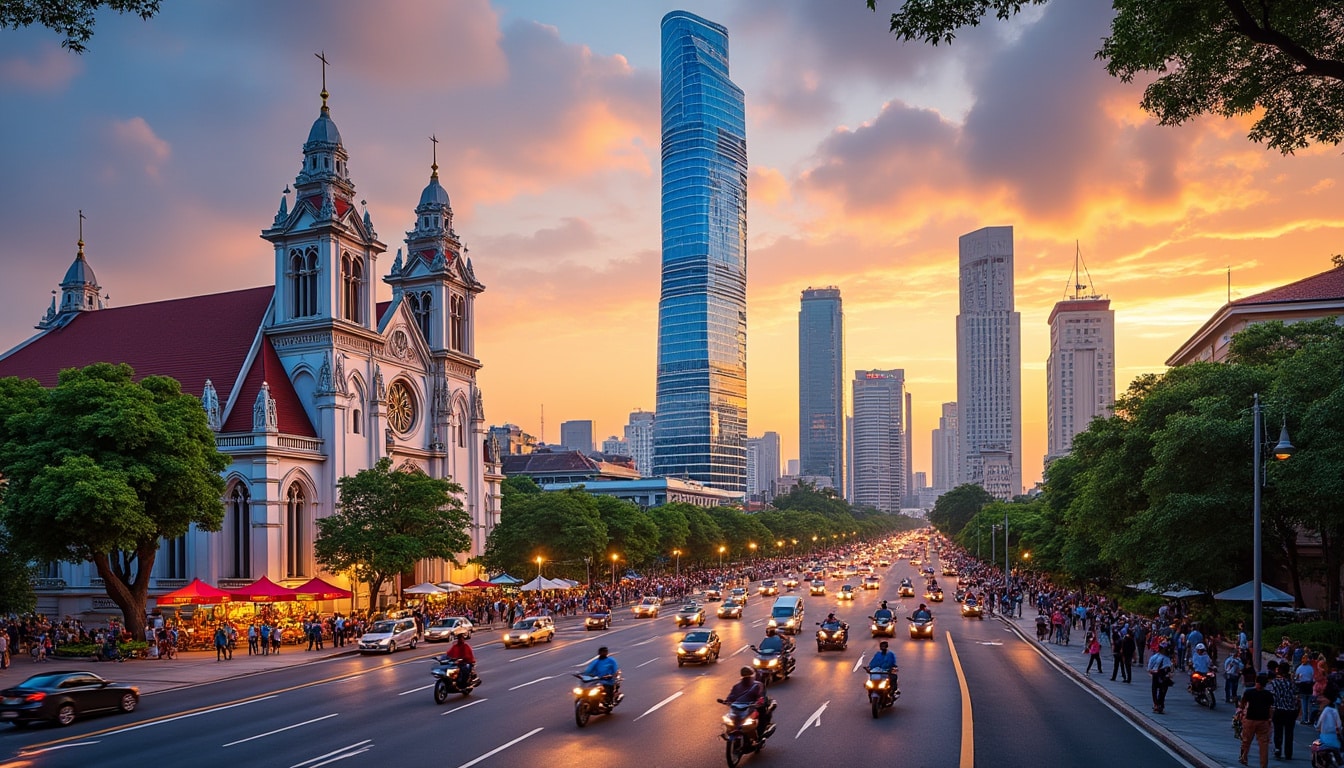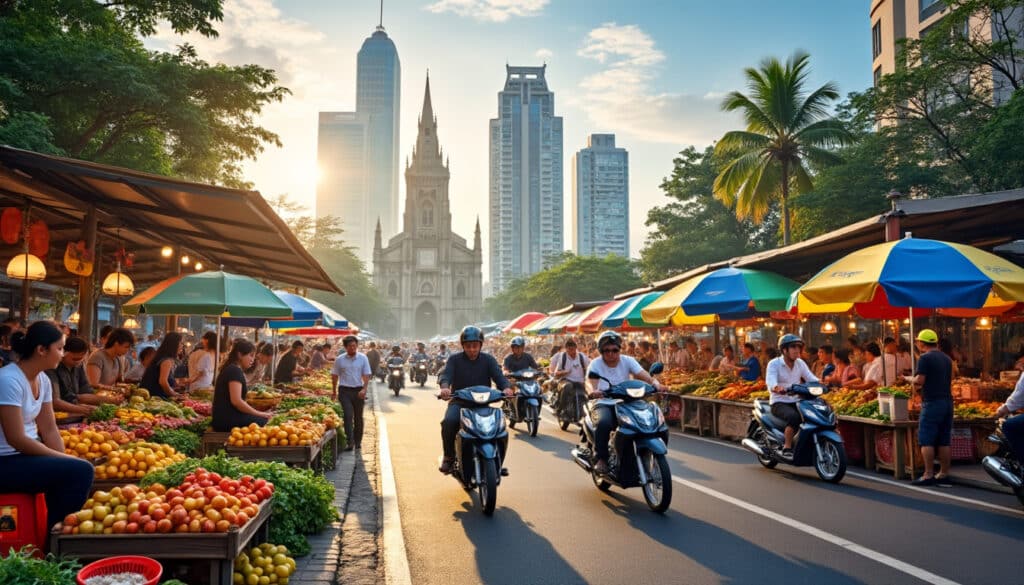Ho Chi Minh City, the bustling economic heart of Vietnam, is a captivating blend of the old and the new, a testament to its ever-evolving architectural landscape. From its historical roots as Saigon, with traditional Vietnamese and French colonial influences, to its modern skyline of towering skyscrapers, the city is a mosaic of styles that reflects Vietnam’s rich history and rapid modernization. This urban explosion is not just about towering buildings; it’s about the dynamic interplay of cultural heritage, sustainable urban design, and innovative urban planning that defines the character of this fascinating metropolis. Whether meandering through the charming alleyways or gazing upon the ultra-modern structures, each corner of Ho Chi Minh City tells a unique story of its architectural journey.
Exploring French Colonial Architecture in Ho Chi Minh
The French colonial architecture in Ho Chi Minh City stands as a tribute to a past era, where European architectural styles mingled with traditional Vietnamese designs. This blend creates an alluring visual narrative that draws the eye and captures the imagination. Many of the structures built during this period remain integral parts of the city’s landscape, serving as vibrant reminders of a fascinating historical chapter.
The Notre Dame Cathedral, for instance, is an iconic example, constructed entirely of materials imported from France. Its red brick façade and stained glass windows are a rare sight amidst the city’s modern growth. Similarly, the Central Post Office, designed by the famed architect Gustave Eiffel, blends Gothic, Renaissance, and French Colonial influences, showcasing a striking façade that is as captivating today as it was at its inception.
These architectural landmarks are not only tourist attractions but also a testament to the colonial impact on Vietnamese culture and urban planning. The careful preservation of these buildings contributes significantly to the city’s cultural heritage sites, emphasizing the importance of architectural restoration in maintaining Ho Chi Minh’s historical integrity.
The preservation efforts are more than a nod to the past; they are a vital part of modern urban planning in Vietnam. By integrating these historical structures with contemporary urban designs, city planners aim to maintain a delicate balance between growth and preservation. This approach not only honors the past but also enriches the city’s identity as a vibrant cultural hub.

Key Characteristics and Elements
The key elements of French colonial architecture in Ho Chi Minh include high ceilings, large windows, and grand doorways, which enhance ventilation—a necessary feature given the city’s tropical climate. These functional aspects are beautifully complemented by decorative elements like wrought iron balconies, intricate tile work, and ornate cornices.
- 🏛️ Use of imported materials for authenticity
- 🌿 Integration with local climatic needs for comfort
- 🎨 Ornamental detailing to enhance aesthetic value
These characteristics not only provide aesthetic pleasure but also tell stories of adaptation and resilience, as architects of the time had to consider the local climate while adhering to European designs. These buildings now serve as educational tools, offering insights into construction techniques and design philosophies from a bygone era.
In conclusion, French colonial architecture stands as a critical component of Ho Chi Minh City’s urban features, offering a unique window into its colonial past. As the city continues to develop, the challenge remains to integrate this historical raphaelito into the broader tapestry of a modern, forward-thinking metropolis.
Modern Skyscrapers: Symbols of Ho Chi Minh’s Growth
In stark contrast to its historical buildings, Ho Chi Minh City’s skyline today is dominated by modern skyscrapers. These soaring structures symbolize the city’s rapid economic growth and its status as a global city. Landmark 81, Vietnam’s tallest building, is a remarkable feat of modern urbanism, standing as a testament to the city’s escalating ambitions.
Landmark 81, an architectural marvel, rises majestically on the banks of the Saigon River, epitomizing the blend of luxury and contemporary design. Its striking presence is not merely for aesthetics—this skyscraper integrates smart city solutions and advanced BIM technology, reflecting the city’s commitment to sustainability and innovation.
| Building | Height | Floors | Completion Year |
|---|---|---|---|
| Landmark 81 | 461.2 m | 81 | 2018 |
| Bitexco Financial Tower | 262.5 m | 68 | 2010 |
| Saigon Centre | 193.7 m | 45 | 2017 |
These skyscrapers are more than just architectural feats; they are vital components of urban planning Vietnam is actively pursuing. Their development underscores the city’s capacity to integrate modern technology with urban expansion projects, ensuring that growth does not compromise livability.
Moreover, the inclusion of sustainable urban design principles in these skyscrapers highlights Vietnam’s commitment to environmental concerns. From green roofs to energy-efficient systems, these buildings reflect a broader shift towards eco-consciousness in architecture—a theme that is becoming increasingly crucial in today’s world.
Impact on the Cityscape
The emergence of these skyscrapers has undoubtedly transformed the cityscape of Ho Chi Minh City. They contribute to a dynamic skyline that serves as a visual representation of the city’s economic vitality and cultural evolution.
- ✨ Creation of a modern urban skyline
- 🚗 Improved infrastructure and transport links
- 🏙️ Enhanced global city appeal
These structures play a pivotal role in defining the urban fabric of Ho Chi Minh City, driving its recognition as a major Southeast Asian metropolis. However, they also present challenges, such as the need for sustainable growth and the preservation of the city’s unique cultural identity amidst rapid modernization.
Integrating Technology in Ho Chi Minh’s Urban Development
Technology plays an indispensable role in shaping the future of Ho Chi Minh City’s urban landscape. With initiatives like the Saigon Hi-Tech Park, the city is at the forefront of integrating modern technology into its urban development strategy.
The deployment of smart city solutions illustrates Ho Chi Minh’s commitment to improving the efficiency and quality of life of its residents. From traffic management systems to public service delivery, technology is central to urban planning in Vietnam, helping to streamline operations and enhance connectivity and sustainability.
Smart City Initiatives
Several initiatives demonstrate the city’s progression towards becoming a smart city:
| Initiative | Focus Area | Impact |
|---|---|---|
| Saigon Hi-Tech Park | Innovation HUB | Promotes tech-based solutions |
| City Operations Center | Traffic & Transport | Improved urban mobility |
| Sustainable Building Codes | Eco-Friendly Design | Reduces carbon footprint |
- 🌐 Enhanced urban connectivity through IoT
- 🛑 Reduction in traffic congestion
- 🌱 Promotion of green building practices
These initiatives exemplify the holistic approach to urban development, addressing the challenges of urbanization while ensuring that cultural and historical elements remain respected and integrated into the broader urban fabric.
The city’s proactive stance on utilizing technology in urban development is a forward-thinking approach that balances modern needs with sustainable practices. As Ho Chi Minh continues to grow, its use of technology will undoubtedly shape its future, making it a model for other emerging cities in the region.
Preserving Cultural Heritage Amidst Urban Expansion
Amidst the rapid urban development in Ho Chi Minh City, preserving cultural heritage sites has gained increasing importance. The juxtaposition of ancient architecture and modern infrastructure creates a unique urban narrative that is crucial for maintaining the city’s identity.
The Reunification Palace and the Jade Emperor Pagoda are prime examples where Vietnamese architecture is preserved with reverence. These sites not only attract tourists but also serve as cultural touchstones for the city’s residents, anchoring the modern metropolis to its rich historical roots.
Strategies for Preservation
Preservation efforts are multifaceted, focusing on integrating heritage within the city’s urban framework without hindering progress:
- 🚪 Restoration and maintenance of historic buildings
- 📜 Documentation of cultural sites for educational purposes
- 🏛️ Adaptive reuse of heritage buildings for modern functions
The City Development Agency plays a pivotal role in balancing these efforts, ensuring that urban expansion does not engulf cultural landmarks. This strategy involves collaborative projects between architects, historians, and local communities to safeguard these sites while accommodating the city’s growing infrastructure needs.
Through architectural restoration and adaptive reuse, Ho Chi Minh is successfully weaving its cultural treasures into the evolving urban tapestry, preserving its historical essence even as it embraces modernity.
Sustainable Urban Design: The Future of Ho Chi Minh City
Sustainability is at the forefront of Ho Chi Minh City’s urban development agenda as it adapts to the challenges of climate change and rapid urbanization. Sustainable urban design focuses on eco-friendly and socially inclusive practices that aim to create a livable environment for future generations.
Green spaces, such as the Tropical Forest Restaurant and innovative projects like the JUICETIN Café, contribute to this sustainable ethos, providing urban oases that enhance the city’s ecology and offering respite from the bustling urban life.
These projects reflect a broader approach to urban planning that prioritizes environmental considerations and social wellbeing. The emphasis is on reducing environmental impact while enhancing the quality of urban life for residents.
Key Principles of Sustainable Design
Ho Chi Minh City implements several principles to achieve its sustainability goals:
- 🌳 Integration of green spaces and public parks
- 💧 Water conservation and management systems
- 🔋 Energy-efficient construction technologies
| Project | Feature | Benefit |
|---|---|---|
| Tropical Forest Restaurant | Green Roof | Improves urban air quality |
| JUICETIN Café | Sustainable Materials | Reduces environmental impact |
| Viczonecode Villa | Solar Panels | Encourages renewable energy use |
The implementation of these principles in urban design fosters a harmonious coexistence between the natural and the built environment, paving the way for Ho Chi Minh to become a leader in sustainable city management.
Overall, the city’s focus on sustainable urban design ensures that growth is balanced with environmental responsibility, enhancing its role as a pioneering force in modern urbanism.
FAQ
What are the main architectural influences in Ho Chi Minh City?
Ho Chi Minh City showcases a blend of French colonial architecture and modern skyscrapers, with elements of traditional Vietnamese design, reflecting its rich history and rapid modernization.
How does technology impact urban development in Ho Chi Minh?
Technology in Ho Chi Minh has significantly enhanced urban development through smart city initiatives, improving transport, connectivity, and sustainability within the urban landscape.
Why is cultural heritage preservation important in Ho Chi Minh?
Preserving cultural heritage sites is crucial for maintaining Ho Chi Minh City’s identity amidst rapid urban expansion, ensuring that its historical roots continue to resonate alongside modern growth.
What is the significance of sustainable urban design in Ho Chi Minh?
Sustainable urban design in Ho Chi Minh City focuses on eco-friendly practices that address environmental concerns and enhance residents’ quality of life, setting a precedent for responsible urban management.
How do modern skyscrapers contribute to Ho Chi Minh City’s development?
Modern skyscrapers contribute by symbolizing economic growth, improving urban infrastructure, and enhancing the city’s global appeal as a major Southeast Asian metropolis.
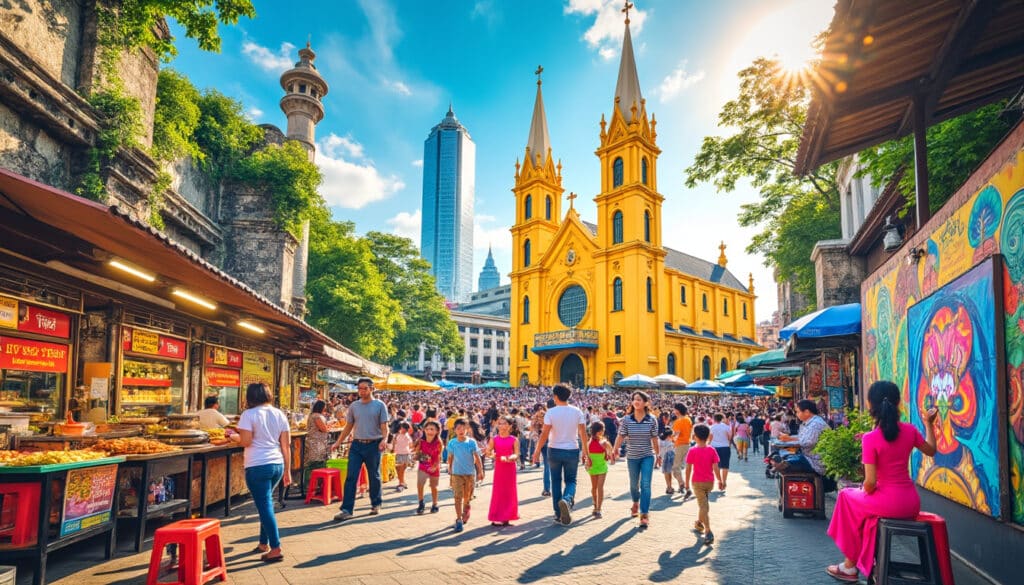
Fun Facts & Curiosities About Ho Chi Minh
Ho Chi Minh City, also known by its former name Saigon, is not just a bustling modern metropolis but a city filled with curious contrasts and intriguing historical narratives. From its storied past as the capital of South Vietnam to…
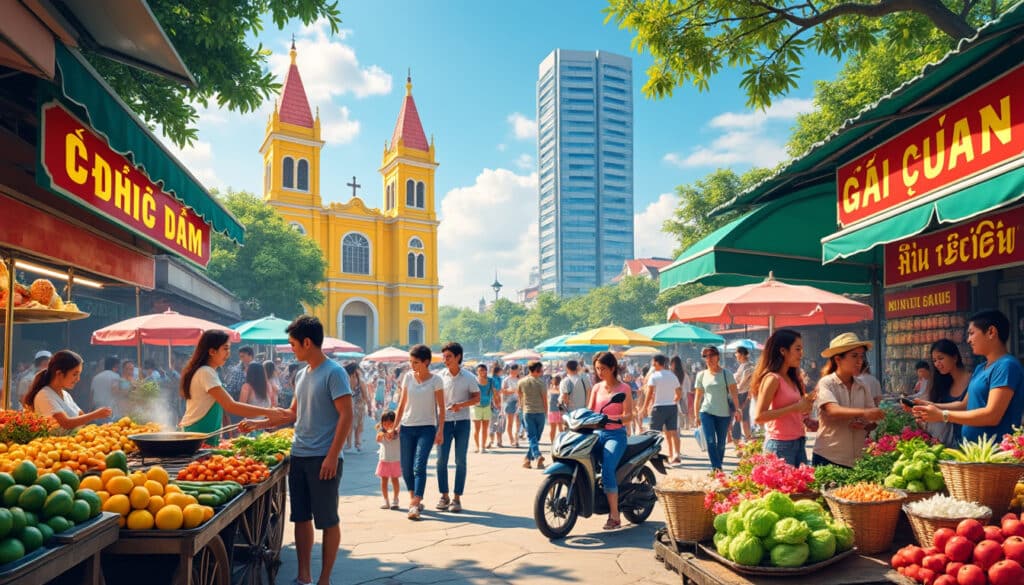
In a world filled with profoundly influential leaders, Ho Chi Minh stands as a towering figure who shaped not only Vietnam but commanded attention internationally. The legacy he left behind continues to resonate in Ho Chi Minh City and across…

Demographics and geography of Ho Chi Minh
Ho Chi Minh City, formerly known as Saigon, stands as a vibrant testament to Vietnam’s blend of tradition and modernity. Nestled between the fertile lands of the Mekong Delta and the bustling southeast, it pulsates with life and energy. As…
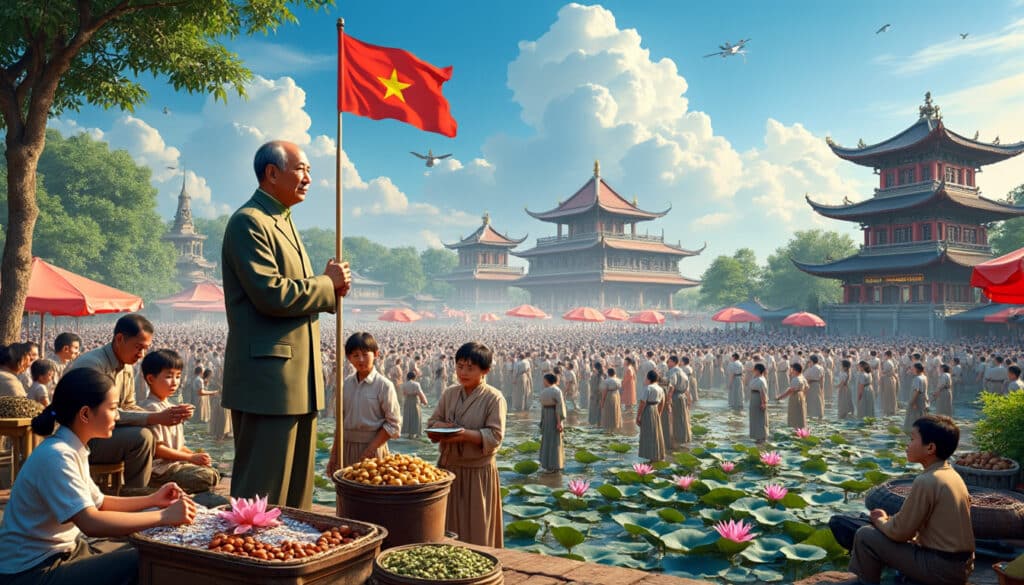
Ho Chi Minh is a name that resonates deeply within the fabric of Vietnam’s history, symbolizing the relentless spirit of independence and nationalist fervor. Known for leading his nation through tumultuous times, Ho Chi Minh was not only a revolutionary…
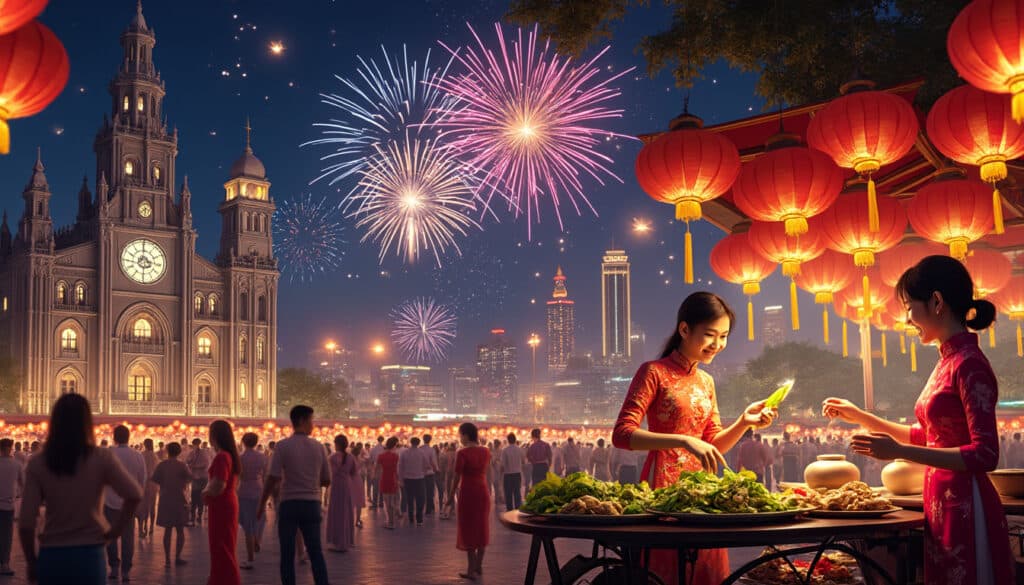
Holidays and celebrations in Ho Chi Minh
Ho Chi Minh City, with its rich tapestry of cultural influences and historical significance, stands as a beacon of celebration in Vietnam. Here, traditions old and new intermingle, creating a vibrant landscape of festivities. From the pulsating energy of the…

Language and spelling of Ho Chi Minh
In the bustling streets of Ho Chi Minh City, language serves as both a bridge and a barrier. The city’s unique linguistic landscape, a product of its rich history and rapid modernization, reflects the dynamic interplay between tradition and change.…
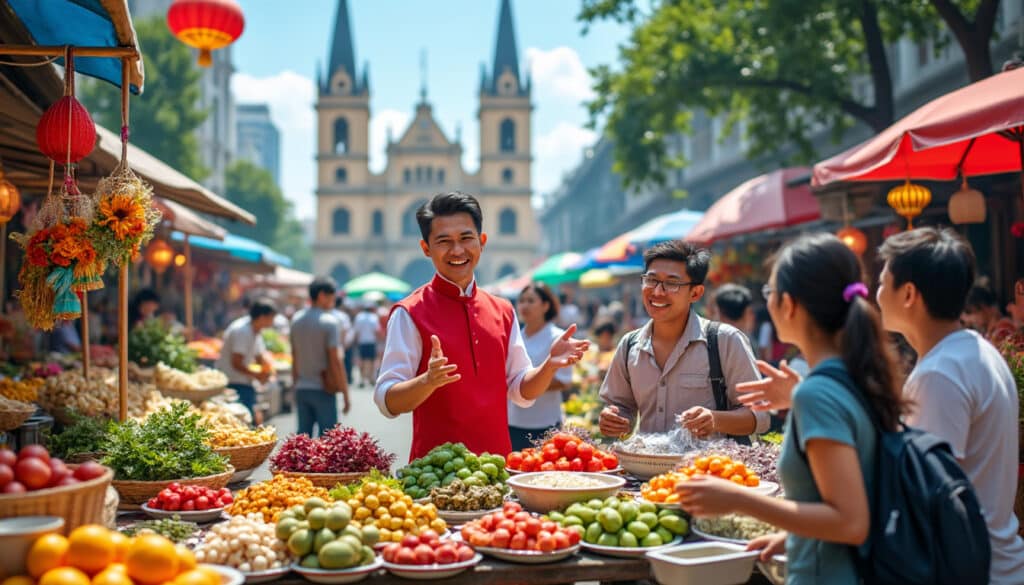
Local tips for tourists in Ho Chi Minh
Ho Chi Minh City, a bustling metropolis teeming with energy, is a gem in Southeast Asia that offers an intoxicating blend of history, culture, and modernity. From its vibrant street markets and delicious street food to its historical sites and…

Names, flags, and identity of Ho Chi Minh
The legacy of Ho Chi Minh is deeply interwoven with the identity and history of Vietnam. Known by many names and represented by various flags throughout his life, Ho Chi Minh remains an iconic figure whose influence extends beyond Vietnam.…
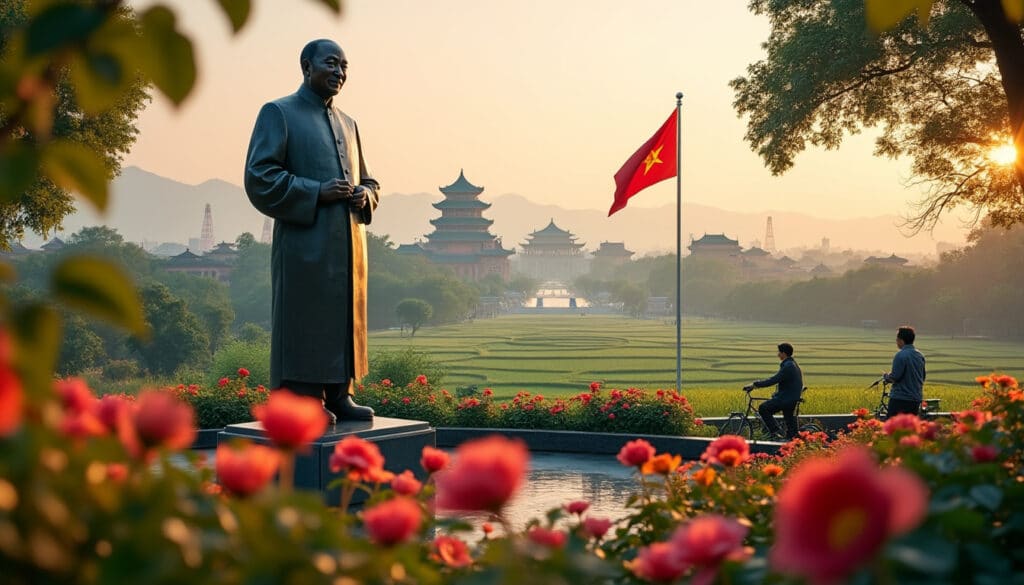
Reputation and identity of Ho Chi Minh
In the heart of Vietnam, the legendary figure of Ho Chi Minh continues to captivate minds, dominating discussions related to national identity and the nation’s storied past. An icon of resilience and strategic acumen, his image is immortalized in everything—from…
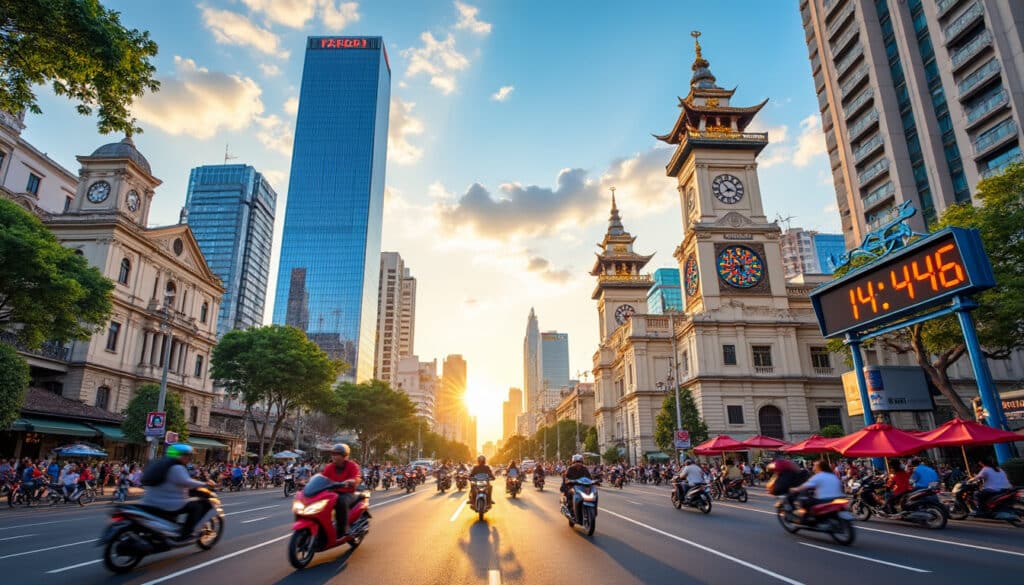
Time and time zone in Ho Chi Minh
Ho Chi Minh City, a bustling metropolis in Vietnam, is a city that never sleeps, where the hum of scooters is the soundtrack to daily life and the aroma of strong coffee permeates the air. It’s a place where time…
Unusual facts and social issues in Ho Chi Minh
Ho Chi Minh City, often referred to as Saigon, is a vibrant metropolis teeming with history, culture, and an array of fascinating quirks. Despite its rapid modernization, the city retains an intricate blend of past and present, where unique facts…

What does Ho Chi Minh look, smell, feel like?
Ho Chi Minh City, often referred to as Saigon, is a bustling metropolis in southern Vietnam that offers an unparalleled sensory experience. From the sleek skyline that reflects its modern aspirations to the fragrant aromas that fill the vibrant streets,…

